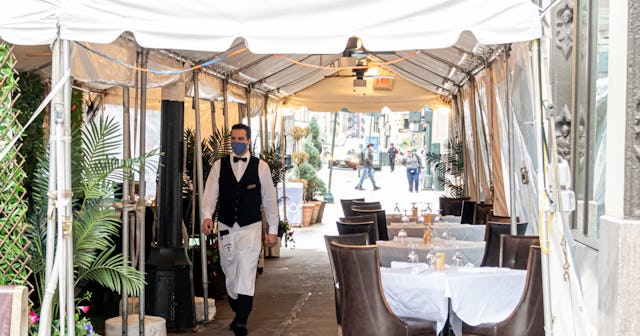Outdoor Dining May Not Always Be 100% COVID Safe

Outdoor tent dining may not be 100 percent COVID safe, according to experts
The restaurant industry has been hit particularly hard during the COVID-19 pandemic. One of the main things that Dr. Anthony Fauci makes clear again and again is that to avoid transmitting COVID-19, staying outdoors is safer than being indoors. To that end, restaurants across the country have gotten creative when it comes to outdoor dining options, some setting up shop in parking lots and, in cities like New York, the sidewalk. Some have even built creative semi-enclosed dining spaces outside, using heat lamps and providing blankets to keep their customers comfortable while dining al fresco. However, according to a new report from the New York Times — and one expert in pandemic preparedness –these makeshift outdoor dining structures may not be completely COVID safe.
The Times points out that by keeping diners safe from the elements, some restaurants have created shelters that “lack sufficient ventilation, raising the risk of transmission.” Additionally, there is also the added risk of outdoor heaters, including portable propane heaters that used to be banned by the city. “Outdoor dining has raised worries among public health and medical experts who warn that it can create a false sense of security that it is inherently safer than being inside,” they explain.
Darren Mareiniss, MD, FACEP, Emergency Medicine Physician at Einstein Medical Center in Philadelphia and expert in pandemic preparedness, tells Scary Mommy that whether or not outdoor dining is safe has everything to do with ventilation.
“When I see the majority of the windows closed in an outdoor dining tent, I think, ‘That is basically being indoors, in a tent,’ because you have created an indoor environment,” he explains. Everything depends on the ventilation in the tent.
“If the windows of the tent are all open and there is good cross ventilation, I would feel safe dining,” he points out. “However, if it is all enclosed, and essentially indoor with poor ventilation, I would avoid it.”
He explains that the ideal situation would be to have openings on all sides — or at least two. “That way you can wash out the stagnant air and aerosolized virus. The idea is not to breathe air with viral particles hanging in it.”
He also points out that there is factor that makes dining outdoors in the winter a little more risky than in the summer: winter air tends to be more dry. “Dry air of winter makes your nasal passages more susceptible to infection,” he points out. Additionally, heat lamps may keep you warm, but they also tend to dry air out.
And, while some restaurants attempt to keep customers warm by handing out blankets, you might want to consider bringing your own. “While majority of transmission is person-to-person, I would still avoid using a communal blanket, unless it was cleanly laundered,” he suggests.